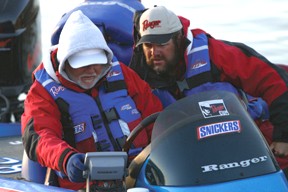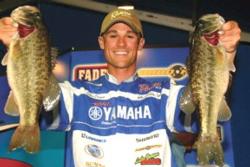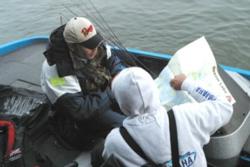Finders keepers

Narrow your search and land more bass
Plus sidebar: ‘How depth finders work’
Locating fish – whether largemouths, spots or smallmouths – is perhaps the most perplexing ingredient in the bass-fishing, make that bass-catching, equation. You can throw every lure in your boat, but if you don’t put them in front of the fish, you might as well go bowling.
Locating bass isn’t as difficult as it seems. In fact, most experienced anglers can make a pretty good assumption of where bass are going to be based on water temperature, the specific season and various other factors. And with the help of a few basic pieces of equipment, along with a good selection of lures and a dose of basic intuition, anybody can locate bass.
Use your tools
The first step lies not in your ability to actually find bass, but to eliminate those places where they aren’t likely to be. A depth finder is critical for that initial search. Technology has helped anglers take a giant leap from making nothing more than an educated guess about what lies beneath their boats to knowing exactly how deep the water is, what the bottom contour looks like and what else might be down there that will hold bass. But at least two FLW Outdoors anglers refuse to call their sonars “fish finders.” True, a quality depth finder can indeed show the telltale arches of fish under the boat, but it’s often impossible to determine exactly what kind of fish they are.
“I don’t really use a depth finder to actually find bass,” said Chris McCollum of New Hope, Ala., a contender in the Wal-Mart Bass Fishing League. “Instead, I use my sonar to find the right features where I expect bass to be during a specific season. I also use it to locate bait. Although the presence of bait isn’t a guarantee that bass will be nearby, it gives me extra confidence.”
 Jetersville, Va., resident John Crews, a rising star on the Wal-Mart FLW Tour, spends a good part of his day simply idling across a lake with both eyes fixed to the screen of his depth finder, but like McCollum, he’s not looking specifically for those arches that indicate fish; he’s looking for various features that bass prefer to utilize.
Jetersville, Va., resident John Crews, a rising star on the Wal-Mart FLW Tour, spends a good part of his day simply idling across a lake with both eyes fixed to the screen of his depth finder, but like McCollum, he’s not looking specifically for those arches that indicate fish; he’s looking for various features that bass prefer to utilize.
“I can make an educated guess as to what type of fish I’m looking at, but if I spent all my time fishing for what I think are bass on my depth finder, I might be wasting my time,” he said. “I mostly want to see features that bass utilize for the season I’m fishing. I can make a pretty good guess as to where the fish are likely to be, and a depth finder helps me find those specific places pretty quick.”
Maps are equally important. They provide not only a large picture of the water, but good topographical maps also show bottom contours and various features such as old road beds and even stump fields left behind when the lake was first built. By using the two together, anglers can narrow their search and fish specific areas that should hold bass.
Go Fishing
No tool will help you actually put a bass in your livewell better than one with a hook on it. That’s why McCollum and Crews stress the importance of keeping your lure in the water. Some lures, however, are clearly better than others when you first search for fish. In fact, most anglers call them “search baits” because they cover lots of water in a short amount of time, and they tend to draw strikes from the most aggressive bass. Spinner baits, crankbaits and even top-waters can give away that critical first fish, which then gives you the confidence you need to establish some sort of pattern.
“I’m going to start out with a spinner bait, a Bomber 6A, a Zara Spook if the season is right, or maybe a YUM lizard on a Carolina rig,” McCollum said. “All of those lures let me cover lots of water in a hurry and find active fish. By catching one or two bass, I can then slow down and start looking for other fish because I can be pretty sure that if an area has one bass, there should be others.”
Crews also likes fast-moving baits, and he will often use a 1-ounce weight on his Carolina rigs. That large piece of lead allows him to feel subtle variations in the bottom, and that can help determine if the area will likely hold bass.
Right under your nose
When it comes down to it, if you’ve put your boat in the water, you’ve already found fish. Although bass do migrate with the seasons, they generally don’t travel that far, and both McCollum and Crews agree that no matter where you end up on any lake, there’s a good chance bass are closer than you realize.
 Researchers at Auburn University startled the bass-fishing community when they conducted an experiment that pitted two skilled anglers against the power of electricity. Vic DiCenzo, now a fisheries biologist with the Virginia Department of Game and Inland Fisheries, took part in the day-long trial on Alabama’s Lake Guntersville in 1994. He and fellow researchers blocked off a 10-acre cove and allowed two bass anglers to fish for four hours.
Researchers at Auburn University startled the bass-fishing community when they conducted an experiment that pitted two skilled anglers against the power of electricity. Vic DiCenzo, now a fisheries biologist with the Virginia Department of Game and Inland Fisheries, took part in the day-long trial on Alabama’s Lake Guntersville in 1994. He and fellow researchers blocked off a 10-acre cove and allowed two bass anglers to fish for four hours.
“They ended up with two bass. One was 16 inches; the other was 18 inches,” DiCenzo said. “Right after they finished, we went in with our shocking equipment, and in a matter of a few hours, we caught something like 20 bass over 5 pounds and gobs of smaller ones. I think we ended up with an average of 34 bass over 10 inches per acre.”
He admits that the day-long project won’t allow biologists to draw concrete conclusions about the ability of bass anglers to find and catch bass, but it does provide important insight into what Crews and McCollum stress: You don’t have to run from one end of the lake to the other to find bass.
DiCenzo recalls numerous occasions when he and other biologists have sampled a section of shoreline only to find that they have been working behind anglers who fished the same shoreline cover.
“We’d come around a corner and we’d see these guys in a boat who just got through fishing the same water we just shocked,” DiCenzo said. “Every time, we’d catch all kinds of bass that they didn’t. I remember one day on Briery Creek Lake (located in central Virginia) where we rolled two 10-pounders and then rounded a point and found two guys who fished through that same water without catching a thing. The bass are there, but they just don’t always get caught.”
Believe in your choices
In other words, it’s not that you haven’t found the fish; you simply haven’t found the right bait to make those fish bite. Confidence – or the lack of it – can often dictate your chances of success – or the lack of it. Both Crews and McCollum will choose a section of a lake based on specific factors such as water color, water temperature, bottom features and available cover and then work that area with the belief that sooner or later, they’ll catch bass.
“When I start searching for bass during a tournament practice period, I’ll just draw an imaginary line across a section of a lake on my map and go spend an entire day fishing that area I marked off,” Crews said. “I know there will be some bass there, and it really pays to get to know a smaller section of a large lake really well.”
 Although he admits to sometimes falling into the trap of running from one end of the lake to the other when he can’t seem to get a pattern going, he tries to avoid spending too much time behind the wheel of his Ranger. Again, time spent driving your boat is time that could be better spent in your effort to find bass. McCollum also sections off a smaller part of a sprawling reservoir and treats it as if it was its own lake. A large cove, a creek arm or even the upper end of a reservoir will all hold some bass throughout the seasons.
Although he admits to sometimes falling into the trap of running from one end of the lake to the other when he can’t seem to get a pattern going, he tries to avoid spending too much time behind the wheel of his Ranger. Again, time spent driving your boat is time that could be better spent in your effort to find bass. McCollum also sections off a smaller part of a sprawling reservoir and treats it as if it was its own lake. A large cove, a creek arm or even the upper end of a reservoir will all hold some bass throughout the seasons.
Once both anglers settle on a specific part of a lake, they’ll stay put, working the entire section with a variety of lures. Crews says he’ll keep his trolling motor in the water for at least an hour before he pulls it up and moves to an entirely different location.
“I can’t stress the importance of covering all the depth ranges,” Crews said. “Bass don’t always follow the rules, and just because you expect to find them deep doesn’t mean that’s where they will be. You have to work each piece of cover with a variety of lures and at different times of the day. The fish may be there; they just may not want what you are offering at that moment. On the other hand, the fish may be in deeper water or in shallower water. That’s why they call it fishing.”
In other words, if you can’t find bass, you may be looking in the wrong place. Try something that may seem so off the wall that nobody else would consider it. And if that fails, remember, even the best bass anglers, the ones whose names appear on tournament checks regularly, don’t always find bass. Or at least they can’t make them bite.
Related article: